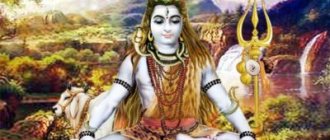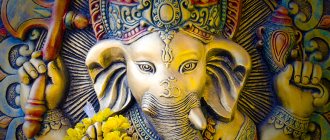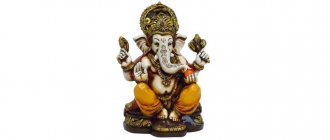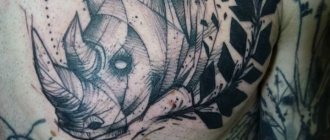Hinduism is a fairly widespread religion throughout the world; according to mythology, it is based on the traditions of the Aryan peoples of Ancient India. At the beginning of the first half of the first millennium AD, two movements emerged in Hinduism - Vaishnavism and Shaivism, named after the deities worshiped by the adherents of these religions - the gods Vishnu and Shiva.
These two deities are among the three most revered gods in India - Brahma, Vishnu and Shiva . It is believed that they are equal in strength, but the direction of their activity is different. Brahma has a creative orientation, i.e. the creator of the world, Vishnu is considered the guardian of the world, and Shiva is called upon to destroy the old world so that its renewal can occur.
Destroying human illusions in life, Shiva appears not only angry, but also all-forgiving, merciful, giving hope and protection. He is a fighter against demonic forces, one of his feats was that he destroyed three cities created by asura demons .
Under pressure, Brahma agreed to the construction of three fortified cities for the sons of the demon Traka. They built one each - in the sky, in the air and on the ground, strengthening them with witchcraft so that they could be destroyed only by a single shot of an arrow. The demons, feeling their strength and invulnerability, decided to defeat the gods and take their place. Shiva burned three cities with one shot, thereby preventing the victory of evil over good.
It is believed that when a new period arises in the life of humanity, Shiva creates it with his dance, and during the end of this period, his dance contributes to its destruction.
The first to worship Shiva were the Dravidians, who inhabited India even before the Aryan civilization. He became the supreme deity in the pantheon of gods they worshiped. According to their belief, it was Shiva who ruled the whole world, as he achieved complete self-improvement and self-realization.
Another revered goddess in India is Lakshmi, the goddess of prosperity.
It is in her honor that the third day of the Indian holiday Diwali takes place.
Shiva - who is this?
In Hindu mythology there is the concept of trimurti, or the Divine Triad, which traditionally includes 3 main manifestations of the One Supreme Being: Brahma (creator of the Universe) - Vishnu (preserver) Shiva (destroyer). Translated from Sanskrit शिव Shiva means “merciful”, “gracious”, “friendly”. In India, the god Shiva is one of the most beloved and revered. It is believed that it is not difficult to call him, Mahadev comes to the aid of everyone, he is the most compassionate god. In its highest manifestation, it personifies the cosmic masculine principle and the highest consciousness of man.
The sacred text "Shiva Purana" presents Shiva with 1008 names that arose when God appeared to people in different guises. Repeating the names of Shiva cleanses the mind and strengthens a person in good intentions. The most famous of them:
- Pashupati (one of the most ancient) - the ruler and father of animals;
- Rudra (furious, red) - personifies the angry nature, brings diseases, but also heals them;
- Mahadev – the greatest, the god of gods;
- Mahesvara - Great Lord;
- Nataraja - Shiva the many-armed king of dance;
- Shambhu – bringer of happiness;
- Ishvara is a lord possessing divine glory;
- Kamari – Destroyer of Desires;
- Maha Yogi - Great Yogi, embodies the spirit of asceticism (revered by all yogis of the world);
- Hara - destroyer;
- Trayambaka - three-eyed.
Female form of Shiva
The left half of Shiva's body represents the feminine (active) energy of Shakti. Shiva and Shakti are inseparable. The many-armed goddess Shiva-Shakti in the form of the deity Kali is the deadly female hypostasis of the destructive energy of Shiva. In India, Kali is sacredly revered, her image is terrifying: blue-black skin, blood-red protruding tongue, a garland of 50 skulls (reincarnations). In one hand is a sword, in the other is the severed head of Mahisha, the leader of the asuras. The other 2 hands bless followers and drive away fear. Kali - Mother Nature creates and destroys everything in her frantic and frantic dance.
Shiva symbol
Images of Mahadev are imbued with numerous symbolism; every detail of his appearance is fraught with a certain meaning. The most important is the sign of Shiva - the lingam. In the Shiva Purana, the lingam is the divine phallus, the source of everything in the Universe. The symbol stands on the base of the yoni (womb) - personifying Parvati, the consort and Mother of all living things. Other attributes and symbols of God are also important:
- The three eyes of Shiva
(Sun, Moon, symbol of Fire) are half open - the flow of life, when the eyelids close, they are destroyed, then worlds are created again, open eyes - a new cycle of earthly life. - Hair
– twisted into a Jatu bun, a unification of physical, mental, spiritual energies; The moon in the hair means control over the mind, the Ganges River cleanses from sins. - Damaru (drum)
– universal awakening, cosmic sound. In the right hand of Shiva, it represents the fight against ignorance and gives wisdom. - Cobra
- entwined around the neck: past, present, future - eternity at one point. - Trident (Trishula)
– action, knowledge, awakening. - Rudraksha (eye of Rudra)
- a necklace made of the fruits of an evergreen tree, compassion and sadness for people. - Tilaka (tripundra)
triple line drawn with ash on the forehead, throat and both shoulders is a symbol of overcoming false knowledge about oneself, susceptibility to Maya (illusions) and the conditioning of karma. - Nandi Bull
is a faithful companion, a symbol of earth and power, a vehicle for the deity. - Tiger skin
- victory over lust.
How did Shiva appear?
The birth of Shiva is shrouded in many secrets; the ancient texts of the Shaivist puranas describe several versions of the appearance of the deity:
- At the moment Brahma appeared from the navel of the god Vishnu, demons were nearby and tried to kill Brahma, but Vishnu became angry, the multi-armed Shiva appeared from between the eyebrows and killed the asuras with a trident.
- Brahma had 4 sons who did not want to have offspring, then a child with blue skin appeared between the eyebrows of Brahma, who was angry at the children. The boy cried and asked for a name and social position. Brahma gave him 11 names, two of which were Rudra and Shiva. Eleven incarnations, in one of them, Shiva is a revered god from the triad of great ones, along with Brahma and Vishnu.
- Brahma, in deep meditation, asked for a son of similar greatness. The boy appeared on Brahma's lap and began to run around the creator asking for a name. "Rudra"! - said Brahma, but this was not enough for the child, he ran and screamed until Brahma gave him 10 more names and the same number of incarnations.
Forms and images
Shiva was first worshiped by the Dravidians, who inhabited India even before the advent of the Aryan civilization. He became the supreme deity in the pantheon of gods they worshiped. According to their beliefs, it was Shiva who ruled the whole world, since he achieved complete self-improvement and self-realization. The Hindu/Vedic Trinity, otherwise known as the Trimurti, consists of three gods: Brahma, Vishnu and Shiva, where Brahma is the creator, Vishnu is the protector and Shiva is the destroyer. This is the true trinity of Vedism, and yet they are inseparable, being different manifestations of one.
Why is God Shiva dangerous?
Mahadev's nature is dual: creator and destroyer. The universe at the end of the cycle must be destroyed, but when Shiva the god is angry, the universe risks being destroyed at any moment. This is what happened when Sati's wife burned in the fire. Shiva created a bloody deity out of himself. The many-armed god Shiva in the form of Virobhadra reproduced himself in thousands like him and went to the palace of Daksha (father of Sati) to inflict wrath. The earth “choked” in blood, the Sun faded, but when the anger passed, Shiva revived all the dead, and put a goat’s head in place of Daksha’s severed head.
Peculiarities
God Shiva is all about contrasts: contemplation and action, creation and destruction, anger and mercy. His image combines many aspects, which is not surprising, because he is considered the Absolute, and the Absolute has everything. He is Mahayogi, the “great yogi,” and also Nataraj, the “king of dance,” but also Mrityunjay, the “conqueror of death,” seated on the throne of Mount Kailash in the Tibetan Himalayas. This is a sacred place of power, which is revered not only by yogis and followers of Shaivism, they strive to climb there, but also by people who study the energy of the earth, its influence on man, his energy and consciousness. Those in the know say that Kailash is truly unlike anything they have seen or experienced before. This is an indescribable experience, after which even great skeptics change their point of view and cast aside all doubts. Lingams also include swayambhus - natural formations resembling the shape of the male genital organ - protrusions and fragments of rocks, tree shapes, etc. Each image created by nature itself has many legends and stories associated with it.
Wife of God Shiva
Shakti is feminine energy, inseparable from Shiva; without it, he is Brahman, devoid of qualities. Shiva's wife is Shakti in earthly incarnations. Sati is considered to be the first wife, because of the humiliation and disrespect of Shiva by her father Daksha, she sacrificed herself through self-immolation. Sati was reborn as Parvati, but Mahadev was so sad that he did not want to leave his many years of meditation. Parvati (Uma, Gauri) performed deep asceticism, thereby conquering God. In her destructive aspects, Parvati is represented by the goddesses: Kali, Durga, Shyama, Chanda.
Resources
You can take care of your health as long as a person does not turn it into an end in itself. In fact, it is possible to strive for health as long as you do not make it an end in itself. This can be difficult to do in our reality, where body worship and concern for increasing life expectancy are imposed everywhere. It has become the new religion of our era. The new god and religion are not “new age” or even “golden calf”, as many tend to think, because wealth usually serves some purpose, unlike the cult of appearance, which gives people the opportunity to prolong their youth and simply show off in front of others. Even inner joy and pride in oneself are also manifestations of the actions of the ego. You may be happy that you've lost a few extra pounds, but continue not to make a cult of it. Live well, take care of your health, do yoga, but don’t let these activities and hobbies completely take over your consciousness. There is no need to become a slave to an idea. There is another mysterious thing associated with the appearance of Shiva. He has three stripes on his forehead. It is usually interpreted as follows: it is a reminder to a person to get rid of ego, karma and illusion (maya), and it can be taken to another level and understood as working on oneself to get rid of these three desires:
Children of Shiva
The Shiva family is a form of Shankara, which is the consciousness that cares about the world. The children of Shiva and Parvati personify the balance of material and spiritual:
- Skandu (Kartikeya), the son of Shiva, the six-headed god of war, was born so strong that at the age of 6 days he defeated the asura Taraka.
- Ganesha is an elephant-headed deity and is revered as the god of wealth.
- Narmada is the daughter of Shiva in a metaphysical sense: in deep meditation on the Armakut hill, Mahadev separated from himself a part of the energy, which was transformed into the virgin Narmada, a sacred river for Hindus.
Character history
Hinduism is one of the three popular religious movements. It is based on the mythology and customs of the Aryan peoples who inhabited Ancient India. This direction is characterized by two movements: Vaishnavism and Shaivism. The followers of the currents worship Vishnu and Shiva. The calling of Shiva is considered to be the destruction of the outdated world in the name of creating a new one. He represents the beginning. The image of the deity is familiar to many from images; non-Westerners know little about its origins and significance in Indian culture.
Legends about Shiva
There are many legends and traditions about the great Shiva, based on texts from the sacred Hindu scriptures of the Mahabharata, Bhagavad Gita, Shiva Purana. One of these stories tells: while churning the ocean of milk, a vessel containing poison emerged from its depths. The gods were afraid that the poison would destroy all living things. Shiva, out of compassion, drank the poison, Parvati grabbed him by the neck to prevent the potion from entering his stomach. The poison colored Shiva's neck blue - Nilakantha (blue-necked) became one of the names of the god.
Shiva in Buddhism - there is a legend about this, which says that in one of his incarnations Buddha (Namparzig) learned about a prophecy: if he appears again in the form of a Bodhisattva, this will not benefit the world, but if he incarnates in the form of Mahadeva, it will be great for the universe good. In Tibetan Buddhism, Shiva is the protector of the teachings and the “Dedication of Shiva” ritual is practiced.
Film adaptations
As the supreme deity, Shiva is often mentioned in cinema. Documentary and feature films have been made about its origin, describing the depth and mythology of the ancient religion. Practicing Saivists make films about the teachings of Shiva. Charana Singh is considered one of these teachers. He teaches followers to correctly understand the covenants and instructions of Shiva, as well as to correctly use the mantras given to them in the course of spiritual practices.
Mohit Raina as Shiva
In the wake of the popularity of serial science fiction films, a project called “God of Gods Mahadev” was created. This is a series whose plot is based on the legends of Shiva. The narrative is created using sacred texts from the Puranas. The story presented by the directors tells the story of the origin of Shiva. It illuminates the union with Shakti, the vicissitudes that accompanied their existence and love. The saga genre is considered a drama in the format of a television project. The film features the work of mythologist Devdutt Pattanaik. The role of Shiva in the series was played by Mohit Raina.
LiveInternetLiveInternet
I saw an image of Shiva in the film “Slumdog Millionaire” and decided to write a little about the Hindu gods at an accessible level. This means that Shiva’s blueness is associated with one of the most global Hindu myths – the churning of the ocean. To obtain the drink of immortality, the maidens (gods) and their younger brothers the asuras (comparable to the Greek titans) churned the ocean. As a whorl, they took the top of Mount Sumer (cf. Olympus) - Mandara. (I’m interested in everything - how was it adapted back then?) They put Mandara on the giant turtle Kurma (according to some versions, this is the incarnation of Vishnu... did he split into two, or what?) As a rope - the naga (snake) Vasuki (according to other versions - Sheshu ). The gods took Vasu by the head, the asuras - by the tail took him for something ) and began to alternately pull him in one direction, then in the other. Over the course of many years (well, of course, why should the gods rush) the ocean turned into milk ( I can imagine how happy all the sea inhabitants were) , and then into oil (here they started dancing) . And in the end, all sorts of interesting things began to appear from the ocean (like that... you, Mowgli, can get whoever you want) . First, the Moon was born from the ocean. Then the goddess Sri (Lakshmi - an analogue of Aphrodite) appeared. All the male gods and asuras were ready to drop everything and rush into battle for her (so ff! Why do we need a drink of immortality when such a woman is?) , but she chose her own husband - Vishnu. Then the magic horse Uchchaikhshravas flew out (analogous to Pegasus, but then the brothers Indra and Surya grabbed him - why do the gods need a flying horse? ). Then the magic stone Kaustubha - Vishnu took it to maintain the balance of power in the world (don’t you think that this guy made a big deal in the process? - I already do) . The penultimate one was the deadly poison Kalakuta, which threatened to destroy all living things. Then Shiva decided to take the blow on himself and swallowed this poison. Being a great god, he, of course, did not die, but turned blue all over. (According to a less popular version, he turned black). (Well, who has a wife, and who...) Well, the last one to come out was an incredibly handsome young man, the god of healing Dhanvantari (analogous to Asclepius) with a cup of amrita - the drink of immortality. (Wow, how long did he sit there!) The gods decided that there wasn’t enough amrita for everyone (the miserable greedy people) , and then Vishnu (I practically love this guy already!) turned into an indescribably beautiful woman Mohini (here’s the world’s first transvestite!) , and all the asuras followed him (that is, the episode with Lakshmi taught them nothing) . At this time, the gods calmly flew away with amrita to Mount Sumer (before this, they probably also collected their belongings - kites, their own, a turtle, fragments of mountains and everything else) . (Hmm, nowhere in the myths is it said how this Susanin, that is, Vishnu, then got out of it when such a crowd of fans realized that he was not a lady after all...) In short, because of the abduction of amrita, wars between gods and asuras began (everyone remembers in Greece, the war of the gods and titans). And Shiva has been blue ever since. By the way, this is how they designate the Trimurti in India - the yellow color stands for the creator of the world Brahma, the red color for the keeper of the world Vishnu, and the blue color for the destroyer of the world Shiva. For some reason, the latter is the most popular among the people. This is worth thinking about...
The meaning and symbolism of Shiva in Hinduism
The religion of Hinduism is full of symbols that embody philosophical movements and teachings, gods and goddesses. It is customary to divide symbols into 2 categories: mudra - gestures and postures, murti - images and images.
Nataraja is the famous image and symbol of Shiva.
Lord Shiva is the king of dancers, the lord of dance. The deity dances in the center of the universe, which personifies the human heart.
Often Rudra is symbolically shown in the form of a lingam, an upright cylinder with a rounded top. Lingam means fusion, dissolution. Shiva from the east is a deity who brings blessings to all beings for fusion.











